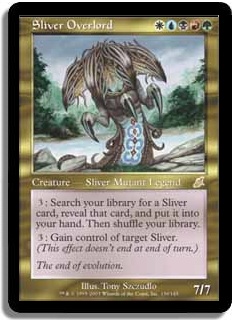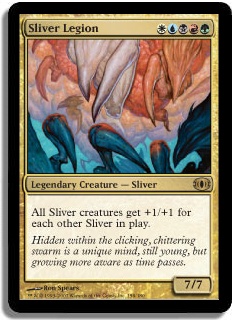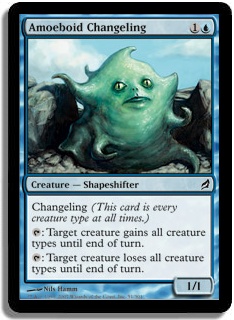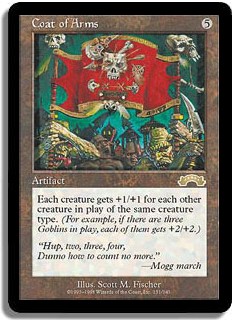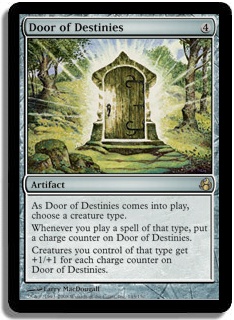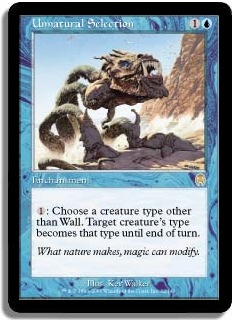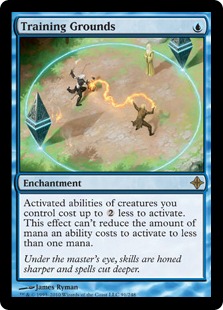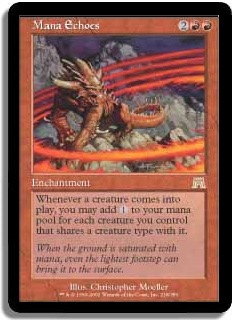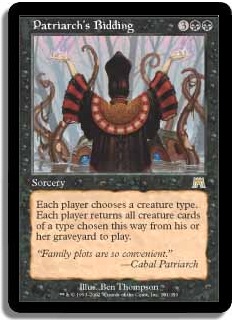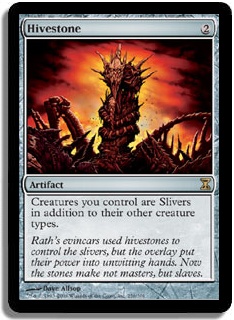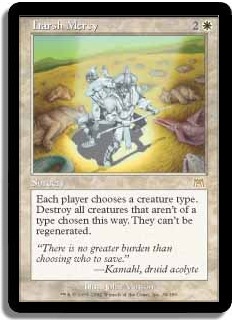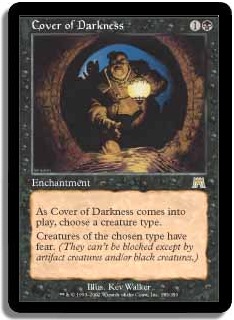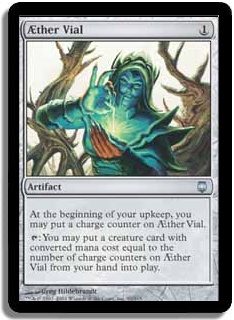Have you heard the news? Slivers are back—and they’ll take on a starring role in M14. I don’t love the hive—linear Draft formats drive me nuts—but I do respect them.
There are a few rules to keep in mind regarding Slivers. First, don’t get them wet. Second, don’t feed them after midnight. Third, don’t ever let Christopher Lee or any other members of the Simic Combine bioengineer them into even crazier monsters (or whatever actually happened in Gremlins 2: The New Batch).
It used to be that there were several tribes that always had casual fans. Dragons and Angels, for example, always held a premium over equivalent cards with other creature types simply because there was always some Dragon kid who would give up his $5 Standard rare for any fire-breathing monster he didn’t have yet. Today, there are only two tribes that still hold a reasonable amount of sway thanks to their creature types: Elves and Slivers. Because of that, knowing your Slivers is very important at the trade tables.
It has been a while since the last time we saw Slivers. They’ve shown up three different times: Tempest block (Tempest and Stronghold), Onslaught block (Legions and Scourge), and Time Spiral block (Time Spiral, Planar Chaos, and Future Sight). Each time Slivers came back, the previous generation of hive members became desirable to players who hadn’t been playing last time Slivers were in Standard.
In the wake of the M14 announcement, Sliver Queen—the grandmother of them all—doubled in price. She’s currently sold out at $50 on StarCityGames.com and has suddenly become the hottest card on the planet. Is that price sustainable for a fifteen-year-old creature? Are there any other Slivers that might jump in popularity once the newest group hits the streets? Are any currently valuable Slivers in danger of having their value destroyed by power creep? It sounds like we’d better take a look at all the Slivers and see how they stack up.
Tempest – Common Cycle
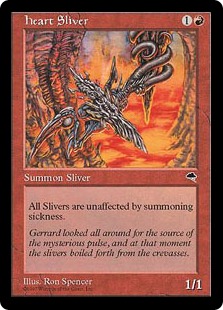
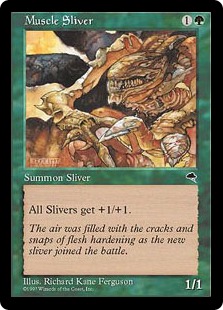
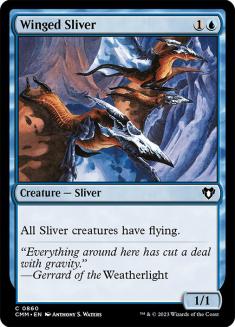
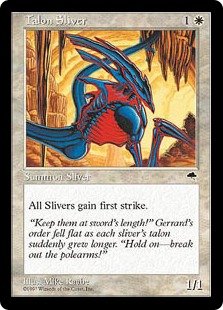
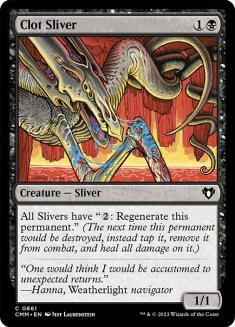
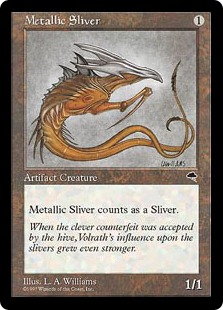
- Heart Sliver – $1
- Muscle Sliver -$1
- Winged Sliver –$1
- Talon Sliver –$0.50
- Clot Sliver –$0.25
- Metallic Sliver – $0.25
These Slivers are easy to examine as a group because of how similar they are. Aside from Metallic Sliver—a vanilla 1/1 for one—all of these Slivers are 1/1 creatures that cost two.
Chances are that M14 will contain common Slivers that will outmode several of these. In fact, some of them were already spoiled—Striking Sliver and Blur Sliver are probably just straight up better than Talon Sliver and Heart Sliver, respectively.
The best card here is Muscle Sliver, and it’s not very close. Essentially, Muscle Sliver is a two mana anthem for your team that’s also pumped by whatever other Slivers you have. Even if they outmode Muscle Sliver, people will want multiple copies of the ability because they stack quite well. Your second Talon Sliver is much worse than your first, for example, but your second Muscle Sliver is much better. Look for it to rise into the $2 range.
Tempest – Uncommon Cycle
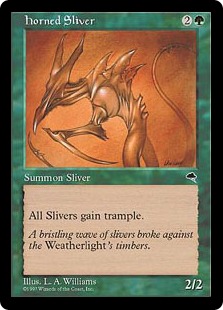
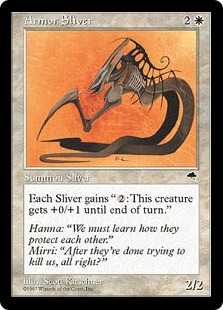
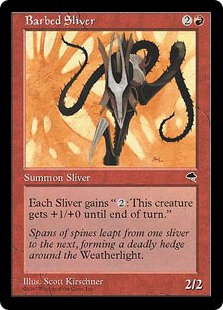
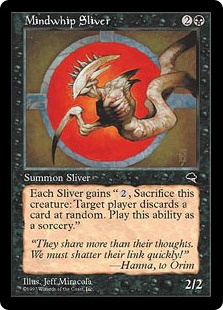
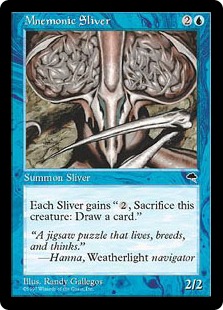
- Horned Sliver – $3.00
- Armor Sliver – $0.50
- Barbed Sliver – $0.50
- Mindwhip Sliver – $0.50
- Mnemonic Sliver – $0.50
This is another simple cycle. There’s one Sliver for each color, and each is a 2/2 for three. Save the green Sliver, each has an activated ability granted to all Slivers that costs two to use. Some of the abilities are okay, but two is a lot of mana to pay for some of these effects and later Slivers will grant some of these abilities for free. This was an era where creatures were much less powerful than they are today.
Horned Sliver, however, is a tier 1 member of the hive. They already spoiled the trampling Sliver from M14, and it costs a whopping seven mana for the same ability. Trample is a must for your Sliver army, and Horned Sliver is still the gold standard. This little guy should trade very well going forward.
Stronghold – Uncommon Cycle
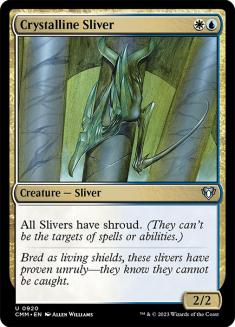
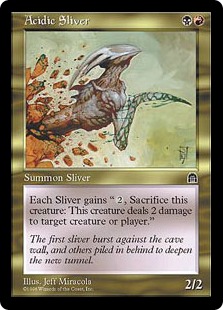
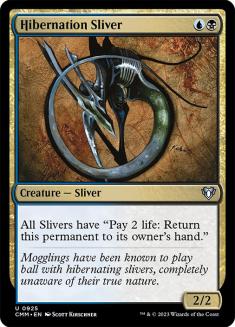
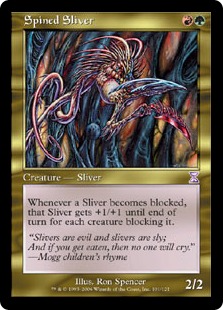
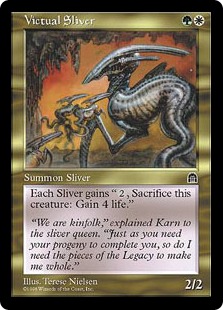
- Crystalline Sliver – $3
- Acidic Sliver – $0.50
- Hibernation Sliver –$0.50
- Spined Sliver – $0.50
- Victual Sliver – $0.50
In the next set, Wizards gave us an uncommon cycle of allied color two-drop gold Slivers. Again, most of these are pretty lousy—years later, it’s kind of hard to see why this tribe was so beloved from the start.
The best one here by far is Crystalline Sliver, an Azorius-colored two-drop who grants your entire team shroud. This is a double-edged sword in a Sliver deck: dodging instant speed removal is great because it prevents you from getting blown out in combat by having a Sliver with an essential ability destroyed at the worst possible moment. At the same time, some later Slivers require being targeted by other members of your swarm in order to work properly. I can smell the hexproof Sliver in M14 from here—it will happen—but we’ll have to see how aggressively costed it ends up being. If it’s too expensive to play, expect Crystalline Sliver to grow a bit in price. Competitive Sliver players have often considered it the strongest one ever printed, even though it frustrates the more casual crowd.
Stronghold – Rare
- Sliver Queen – $50.00
Sliver Queen, in my opinion, is the reason that Slivers became as popular as they did. She was the first five-color creature, and the fact that she’s still a casual powerhouse today shows just how busted she was back then. Most creatures from that era are horribly outclassed, but the Queen actually gets better the more Slivers are printed—after all, pumping out X/Xs with tons of abilities for two mana is one of the strongest late game plays you can make.
The Queen is also on the reserved list, so if Wizards of the Coast wants to obsolete her they’ll have to print something distinctly better. I don’t think that’s something they intend to do, though I do expect a five-color gold Sliver mythic will be one of the chase cards of the set.
What is Sliver Queen actually worth? She jumped from $30 to $65 in a single day before settling at $50 as people dug copies out of binders and listed them online. I think everyone expecting growth beyond this point is fooling themselves—casual players are simply unwilling to shell out as much cash for a single card as competitive players are. If you’re building U/W in Legacy, for example, you are pretty much toast if you can’t afford the Tundras and Flooded Strands. If you’re building a Sliver deck for Commander play, though, there are some alternatives to the Queen even if they aren’t as good. Riptide Replicator, for example, or Sliversmith.
That said, I wouldn’t be shocked if $50 ends up being the new stable price for Sliver Queen. She retains a near-mythical quality about her that very few cards have ever had. If you find someone willing to sell you a copy at $30 believing the new price can’t sustain itself, make the deal.
Legions – Common Cycle
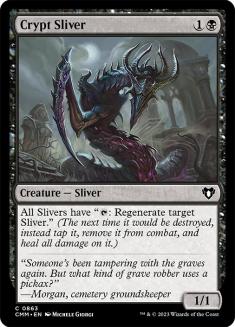
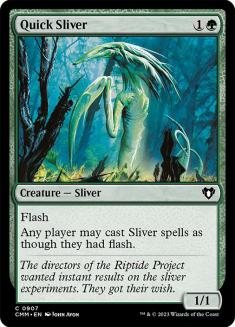
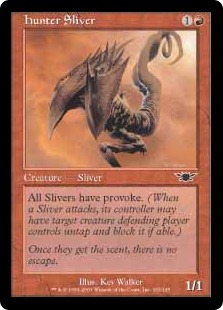
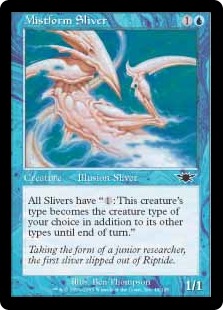
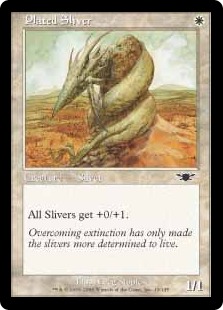
- Crypt Sliver –$0.50
- Quick Sliver – $0.25
- Hunter Sliver – $0.25
- Mistform Sliver –$0.15
- Plated Sliver – $0.15
This cycle is nearly identical to the Tempest commons in form. There’s a Sliver for each color, and they’re all 1/1s for two except Plated Sliver, who costs just one.
Mistform Sliver is pretty worthless—you don’t want your Slivers to be anything but Slivers, really—and was really just a card for the OLS Limited format. The others are all quite interesting, though. Crypt Sliver is the best of the regeneration-granting Slivers, Plated Sliver is a one-drop with a reasonable effect—Slivers is an aggressive deck without many ones—and flash is very hard to play around. Provoke is underrated because most Sliver players are simply looking to kill their opponent dead as quickly as possible. The ability to pick off utility creatures in the process is exceedingly powerful.
These Slivers are all rather cheap, but you might be able to trade them at $1 each or so while M14 is legal. Foils are also worth looking out for. These kinds of trade table victories can add up.
Legions – Uncommon Cycle
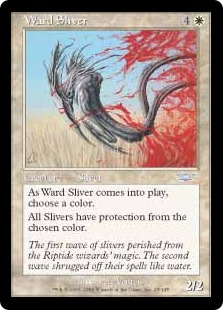
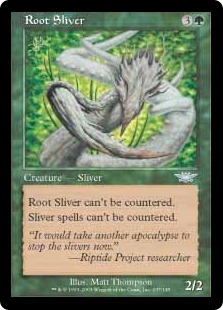
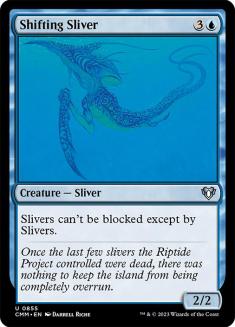
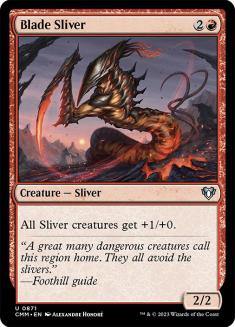
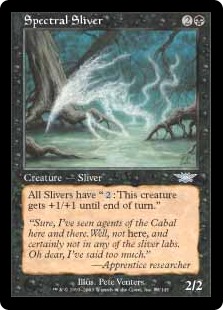
- Ward Sliver –$2
- Root Sliver – $2
- Shifting Sliver – $2
- Blade Sliver – $0.50
- Spectral Sliver – $0.50
All of these guys are pretty good. Even the 50-cent Blade Sliver gives you the best half of an anthem and shouldn’t be overlooked. Spectral Sliver can make combat a nightmare. Root Sliver’s uncounterability makes him a must for the causal players who loathe counterspells above all else—a larger contingent than one might think. Shifting Sliver and Ward Sliver each have the most powerful abilities, but they cost four and five mana each, respectively. These two cards have been $2+ forever, but the demand has never really been there. Ward Sliver’s ability is fairly unique, but as you’ll see coming up, Shifting Sliver’s unblockability isn’t as special as you might think.
Legions – Rare Cycle
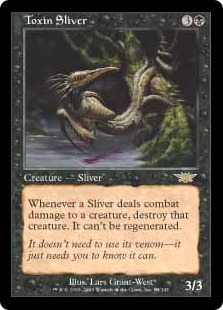
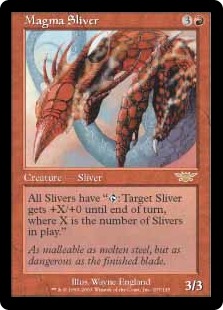
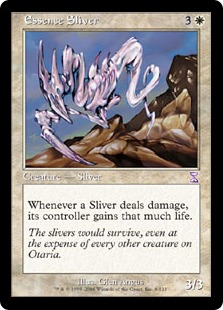
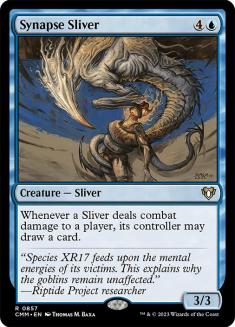
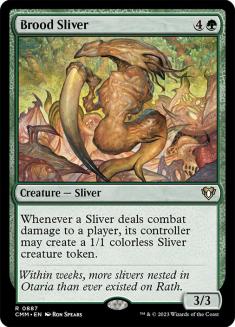
- Toxin Sliver – $9
- Magma Sliver – $5
- Essence Sliver – $3.50
- Synapse Sliver – $3
- Brood Sliver – $2
Legions was seen as kind of a lousy set when it came out, but these Slivers all pack a wallop. All of these creatures have a shot at seeing play in a casual Sliver deck today, and you should look to pick them up in trade when you can. Toxin Sliver has been $8-$9 for years—it was always one of those “gotcha” cards that value traders would use as a benchmark back in the “what do you value this at?” days. The card got even better when Commander became the default casual format because keeping an army of deathtouch Slivers back often gives you enough time to amass a lethal army. I could see it hitting $12-$15.
Scourge – Rare
- Sliver Overlord – $6
Anyone running Sliver Queen over this as their commander is doing so only for the flavor. This is by far the more powerful Sliver general, seeing as it can fetch up the Queen and all of her companions by itself. If it wasn’t for the Premium Deck Series: Slivers box set a few years back, I would expect this card to hit $20 this year without breaking a sweat. Instead, it has lagged around in the $3-$4 range for some time before recently hitting $6. This card could go as high as $10, but I need to see real world demand before I call for a buy. I’ve had no problem trading and selling Sliver Queens and Toxin Slivers for years, but everyone who wants a Sliver Overlord already seems to have one.
Time Spiral – Common Cycle
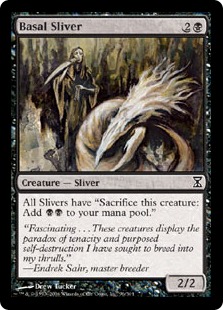
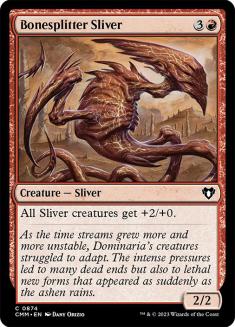
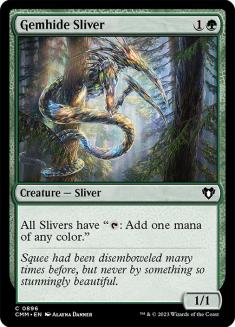
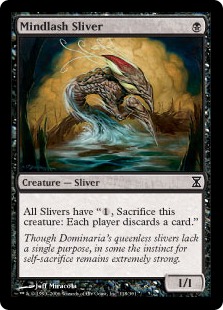
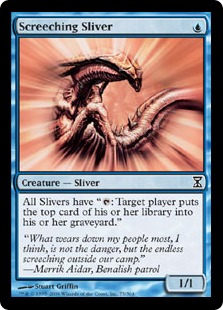
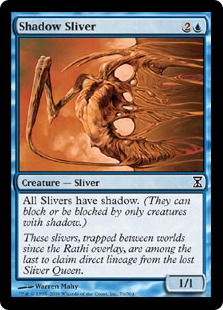
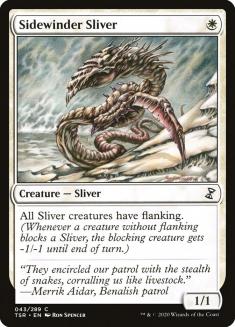
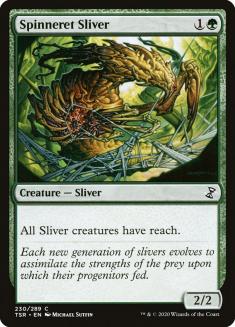
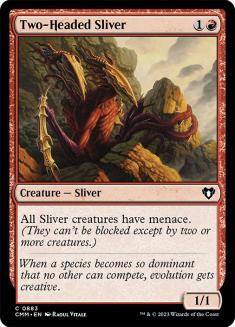
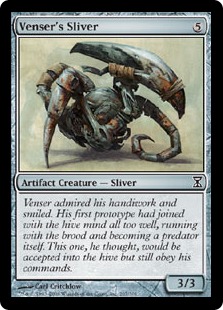
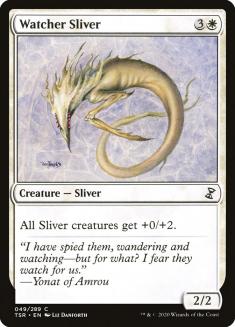
- Basal Sliver – $0.25
- Bonesplitter Sliver – $0.25
- Gemhide Sliver – $1
- Mindlash Sliver – $0.25
- Screeching Sliver – $0.25
- Shadow Sliver – $0.25
- Sidewinder Sliver – $0.50
- Spinneret Sliver – $0.25
- Two-Headed Sliver – $0.25
- Venser’s Sliver – $0.15
- Watcher Sliver – $0.25
This time around each color got two common Slivers along with one Sliver artifact. The best one here by far is Gemhide Sliver, which turns your whole team into Birds of Paradise. When you’re playing all five colors, this versatile acceleration and fixing is essential. My favorite thing to do is to pair this with Quick Sliver, allowing you to tap your team in order to flash more Slivers into play. Also underrated: Shadow Sliver. This gives you the functionality of Shifting Sliver for just $0.25, and I’m shocked it doesn’t trade higher. Bonesplitter and Sidewinder Slivers are also outstanding.
Time Spiral – Uncommon Cycle
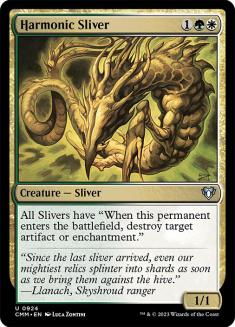
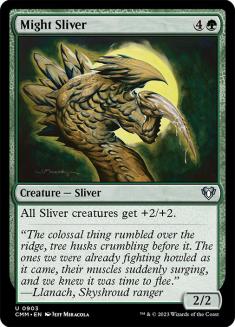
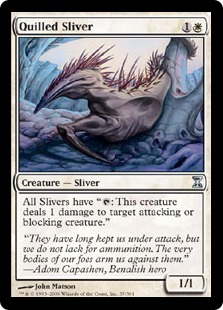
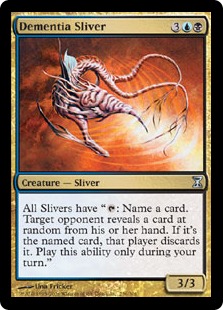
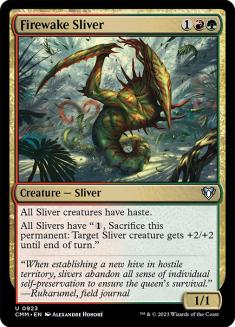
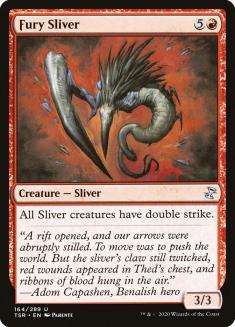
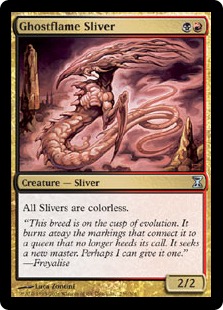
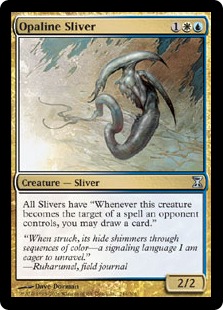
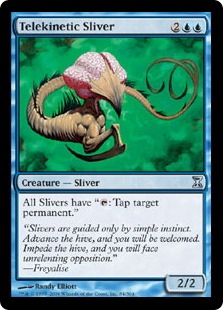
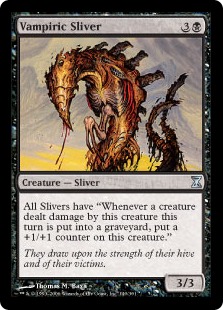
- Harmonic Sliver – $2
- Might Sliver – $1
- Quilled Sliver – $0.75
- Dementia Sliver – $0.50
- Firewake Sliver – $0.50
- Fury Sliver – $0.50
- Ghostflame Sliver – $0.50
- Opaline Sliver – $0.50
- Telekinetic Sliver – $0.50
- Vampiric Sliver – $0.50
For the uncommons, each color and allied color paring got a Sliver. The two winners here are Harmonic Sliver—growing your army while nuking stuff on the multiplayer table is insane—and Might Sliver, giving you two Muscle Slivers stapled together. Both should continue to trade well. My sleeper pick here is Opaline Sliver, a nice deterrent against targeted removal.
Time Spiral – Rare Cycle
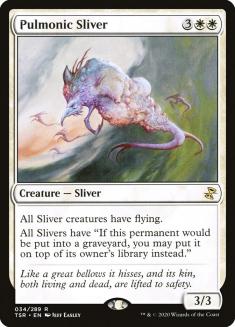
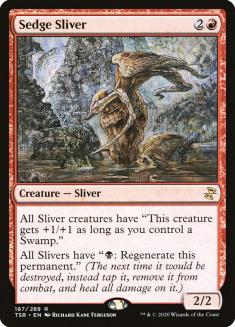
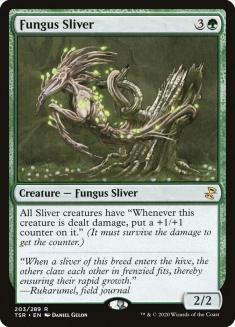
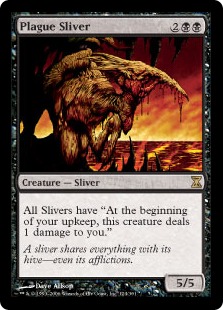
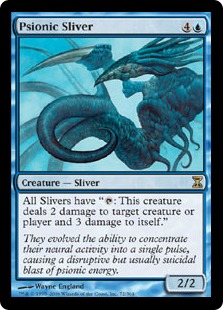
- Pulmonic Sliver – $2
- Sedge Sliver – $1
- Fungus Sliver – $0.75
- Plague Sliver – $0.50
- Psionic Sliver – $0.50
Ugh, we got kind of a lousy batch of rare slivers this time out. I guarantee you that M14 will have far better options—creatures are pushed today in a way that they weren’t at all in Time Spiral. The bottom three on this list are pretty useless—Plague Sliver actively hurts you for having more Slivers and isn’t really good enough to be a sideboard card against them—though the first two have promise.
Sliver decks are kind of like the Zerg—if you fail in your initial rush or fall victim to a sweeper, you’re in a bit of a bind. Pulmonic Sliver’s second clause offers a small bit of protection, as does Sedge Sliver’s regeneration. It’s Sedge Sliver’s first ability, though, that makes it shine. Anthems are essential in Sliver decks, and with all the shocklands running around, you’ll almost always have a Swamp. I like both of these as sleeper buys right now.
Planar Chaos – Common Cycle
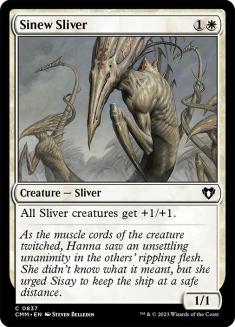
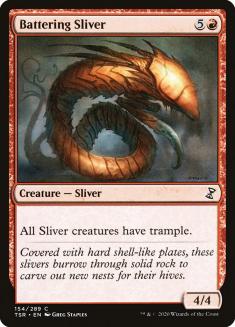
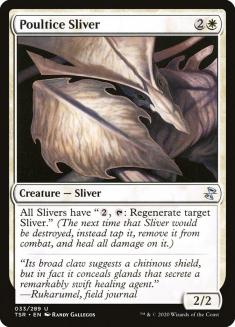
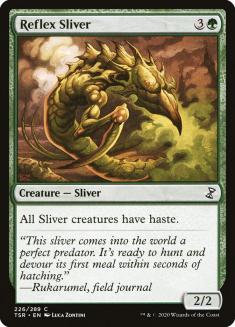
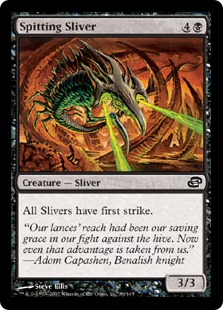
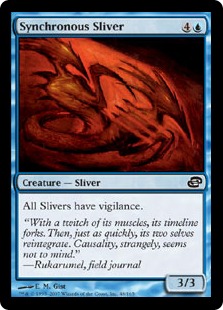
- Sinew Sliver – $0.50
- Battering Sliver – $0.25
- Poultice Sliver – $0.25
- Reflex Sliver – $0.25
- Spitting Sliver – $0.25
- Synchronous Sliver – $0.25
The commons here are all Limited fodder except for Sinew Sliver, the color-shifted Muscle Sliver. This one is certainly worth picking up, and I can see it hitting $1+ without much trouble.
Planar Chaos – Uncommon Cycle
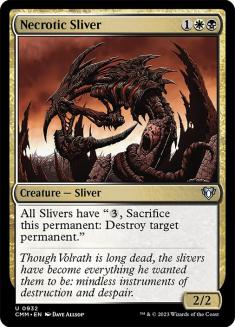
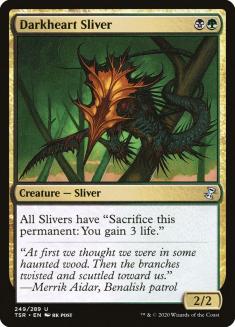
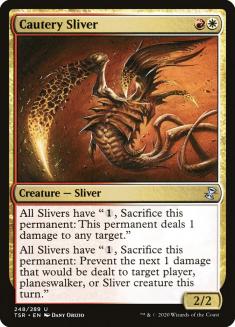
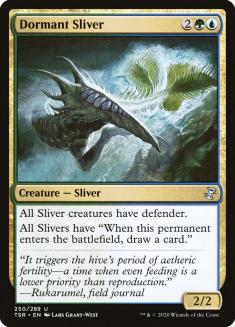
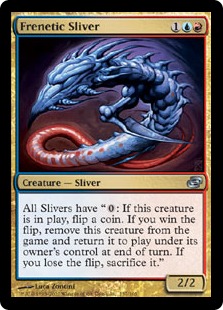
- Necrotic Sliver – $2
- Darkheart Sliver – $0.75
- Cautery Sliver – $0.50
- Dormant Sliver – $0.50
- Frenetic Sliver – $0.50
At last, a cycle of enemy-colored gold slivers. Necrotic Sliver, who turns all of your hive members into walking Vindicates, is easily the best of them. Again, if this card hadn’t been reprinted in the box set, I think the value could rise quite a bit. It was, though, so its ceiling is limited.
Darkheart Sliver and Frenetic Sliver are both pretty good as well. Darkheart allows you to gain quite a bit of life if your army gets fried, and Frenetic Sliver allows you to save half your team in the event of a sweeper. People are scared away by the coin flip clause, but this guy is an under-the-radar gem for sure.
Future Sight – Common Cycle
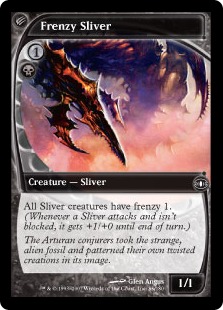
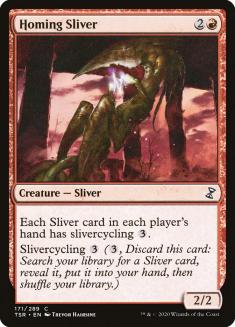
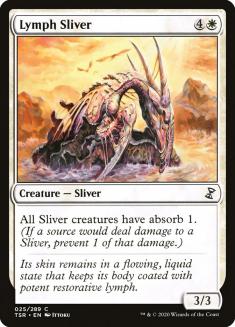
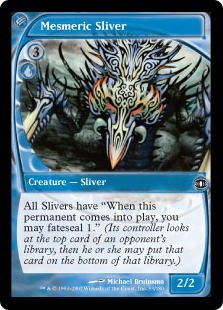
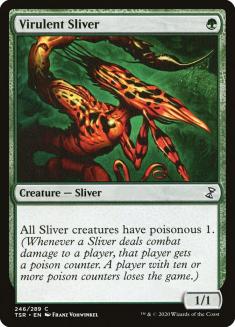
- Frenzy Sliver – $0.25
- Homing Sliver – $0.50
- Lymph Sliver – $0.25
- Mesmeric Sliver – $0.25
- Virulent Sliver – $0.50
It’s a shame that infect hadn’t been conceived of yet because we assuredly would have gotten an infect Sliver in Future Sight—of course, it probably would have cost quite a lot of mana. We won’t get one in M14 sadly—no ability that confusing going into a core set. Poisonous is still powerful, though, and Virulent Sliver threatens to get pretty scary. Homing Sliver is another great one—tutoring is awesome, and this common is probably a little underrated. Lymph Sliver made for some annoying limited games, but it’s not even really a casual Constructed card.
Future Sight – Rare
- Sliver Legion – $25
This card has already shot up in price—it was $15 before the M14 Slivers were spoiled, and now it’s $25. Believe it or not, this is quite possibly an even more powerful card than Silver Queen, and if it isn’t reprinted I could see it trading for an easy $30 or more in a couple of months.
The problem, of course, is that if Wizards of the Coast decides to go with a mythic rare reprint, Sliver Legion fits the bill. If they go that way, expect this card to take an Akroma’s Memorial sized drop into the single digits. Buy at your own risk.
Sliver-Adjacent Cards
Like peanut butter and jelly, certain cards are perfect complements to a casual Sliver strategy. These cards are all worth sticking in a Sliver section of your casual binder for the M14 Prerelease and beyond:
Amoeboid Changeling – $0.25
Not only can this guy turn your utility creatures into Slivers, but you can use him on your opponents’ creatures to steal them permanently with your Sliver Overlord. Pick these up in foil.
Coat of Arms – $5
When Sliver Legion isn’t enough, Coat of Arms is here to help.
Door of Destinies – $10
Sliver Legion #3. This card is already $10, so I doubt it’ll grow any further.
Unnatural Selection – $1
This is a nice little stealth pickup from Apocalypse. It does similar work to Amoeboid Changeling but with multiple activations each turn. It’s also harder to kill.
Training Grounds – $2
Most of the Slivers with activated abilities that cost mana are kind of lousy. If you’re planning to run some number of them, though, this is a must. A good buy if any of the better M14 Slivers have these abilities.
Mana Echoes – $2
This can generate an absurd amount of colorless mana in a hurry.
Patriarch’s Bidding – $6
This casual superstar is eventually going to be a $12-$15 card. The M14 Slivers might finally give it that last push.
Hivestone – $1
This doesn’t play as well with Sliver Overlord as Amoeboid Changeling and Unnatural Selection do. If you’re playing a Sliver deck, at least 95% of your creatures should be Slivers already—they get exponentially better the more you have, after all.
Harsh Mercy – $0.50
This “sweeper” allows your opponent to keep their best creature, but it also lets you keep your whole army. Think of it as a very good Diabolic Edict.
Cover of Darkness – $2.50
This gives you another way to give your full team evasion—one that isn’t as prone to an errant spot removal spell.
Aether Vial – $18
This card’s competitive playability is why it’s an $18 card, so I don’t see new Slivers causing it to rise in value. That said, it’s a must in any good Sliver deck, so if you’re looking to trade yours and you’re engaged in a trade with a Sliver brewer, feel free to remind them just how powerful it is in a five-color creature-heavy deck.
Premium Deck Series: Slivers – $99
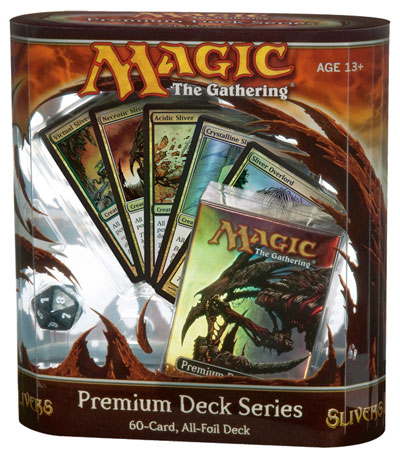
This deck is full of great Slivers. You can’t really play it out of the box because the mana is pretty bad, but otherwise it’s a fantastic starting point for a fledgling Sliver deck. I’ll admit that I was shocked to see a retail price of $99 on this—copies sat at my local stores for years before they were finally all sold. It has been long enough, though, and this is indeed a sought-after box set now.
This Week’s Trends
– I don’t like to say “I told you so” all that often because there are a ton of things I get wrong, but I got raked across the coals by a large number of you last fall for saying that the Ravnica block shocklands would stabilize in the $8-$12 range through the spring. Well, that’s exactly where they’ve ended up. The increased supply of Dragon’s Maze shocked has caused the trade value to come down even a little bit off that, though the retail price hasn’t budged yet. These will probably come down a dollar or two more, but at some point late this summer they’ll probably jump into the $20 range for the fall. Don’t miss out.
– The new event deck has THREE copies of Lingering Souls in it. Don’t sell now—it’s too late. Hold ’em for a few years—the card is great in nearly every format.
– Someone randomly decided to buy out all the Tempest Medallions, so they’ve all gone up into the $7+ range. I still think these have a shot at being reprinted (they were heavily featured in DOTP 2013), and I wouldn’t touch them at this price.
– Deadbridge Chant doubled in price to $8. It saw a tiny bit of Constructed play last weekend, but it was mostly due to casual demand. I see it settling in around $6 unless something changes.
– A $50,000.00 card collection was stolen from a locked car at #SCGNJ. Please don’t carry around this many valuable cards at one time, okay? You can’t possibly need that much trade stock. $50K is a down payment on a house or a super nice car. Don’t leave that in your trunk.
Until next time –
– Chas Andres


